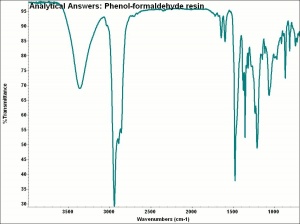Difference between revisions of "Phenol formaldehyde resin"
(username removed) |
(username removed) |
||
| Line 1: | Line 1: | ||
== Description == | == Description == | ||
| − | A thermosetting [http://cameo.mfa.org/materials/fullrecord.asp?name=amino | + | A thermosetting [http://cameo.mfa.org/materials/fullrecord.asp?name=amino%20resin amino resin] that is made by reacting [http://cameo.mfa.org/materials/fullrecord.asp?name=phenol phenol] with [http://cameo.mfa.org/materials/fullrecord.asp?name=formaldehyde formaldehyde]. Discovered in 1907 by Leo Baekeland and sold as [http://cameo.mfa.org/materials/fullrecord.asp?name=Bakelite Bakelite] in 1909, phenol formaldehyde resin was the first true synthetic plastics. Phenolic resins can be made with either excess formaldehyde (resol) or with an excess of phenol (novolac). Resols are soluble in alcohol while novolacs are solid at room temperature. Both require crosslinking tod form a hard plastic that is brittle but has good resistance to water and biodegradation. In the early 20th century, phenol formaldehyde resins were used for dark color molded plastic products sometimes filled with [http://cameo.mfa.org/materials/fullrecord.asp?name=cellulose cellulose], [http://cameo.mfa.org/materials/fullrecord.asp?name=wood%20flour wood flour], or mineral powders. Resol phenolics are currently used for plywood, textile sizing, leather processing, paper strengthening, foams and chemical resistant coatings. Novolacs are used for fibers, adhesives, molded parts, circuit boards, and mechanical fittings. |
== Synonyms and Related Terms == | == Synonyms and Related Terms == | ||
| Line 35: | Line 35: | ||
== Authority == | == Authority == | ||
| − | * | + | * G.S.Brady, ''Materials Handbook'', McGraw-Hill Book Co., New York, 1971 Comment: p. 598 |
* ''Dictionary of Building Preservation'', Ward Bucher, ed., John Wiley & Sons, Inc., New York City, 1996 | * ''Dictionary of Building Preservation'', Ward Bucher, ed., John Wiley & Sons, Inc., New York City, 1996 | ||
| − | * | + | * Pam Hatchfield, ''Pollutants in the Museum Environment'', Archetype Press, London, 2002 |
| − | * | + | * Thomas C. Jester (ed.), ''Twentieth-Century Building Materials'', McGraw-Hill Companies, Washington DC, 1995 |
| − | * | + | * Sharon Blank, An introduction to plastics and rubbers in collections, ''Studies in Conservation'', 35, 53-63, 1990 |
* Art and Architecture Thesaurus Online, http://www.getty.edu/research/tools/vocabulary/aat/, J. Paul Getty Trust, Los Angeles, 2000 | * Art and Architecture Thesaurus Online, http://www.getty.edu/research/tools/vocabulary/aat/, J. Paul Getty Trust, Los Angeles, 2000 | ||
Revision as of 07:32, 24 July 2013
Description
A thermosetting amino resin that is made by reacting phenol with formaldehyde. Discovered in 1907 by Leo Baekeland and sold as Bakelite in 1909, phenol formaldehyde resin was the first true synthetic plastics. Phenolic resins can be made with either excess formaldehyde (resol) or with an excess of phenol (novolac). Resols are soluble in alcohol while novolacs are solid at room temperature. Both require crosslinking tod form a hard plastic that is brittle but has good resistance to water and biodegradation. In the early 20th century, phenol formaldehyde resins were used for dark color molded plastic products sometimes filled with cellulose, wood flour, or mineral powders. Resol phenolics are currently used for plywood, textile sizing, leather processing, paper strengthening, foams and chemical resistant coatings. Novolacs are used for fibers, adhesives, molded parts, circuit boards, and mechanical fittings.
Synonyms and Related Terms
phenol-formaldehyde resin (AAT); phenolic resin; PF; novolac; resol; Bakelite
Other Properties
Sensitive to acids and alkalis
| CAS | 9003-35-4 |
|---|
Hazards and Safety
Evolves formaldehyde and ammonia as it degrades. Can corrode copper and brass.
ASIA PACIFIC MICROSPHERES SON: MSDS
Comparisons
General Characteristics of Polymers
Physical Properties for Selected Thermoset Resins
Authority
- G.S.Brady, Materials Handbook, McGraw-Hill Book Co., New York, 1971 Comment: p. 598
- Dictionary of Building Preservation, Ward Bucher, ed., John Wiley & Sons, Inc., New York City, 1996
- Pam Hatchfield, Pollutants in the Museum Environment, Archetype Press, London, 2002
- Thomas C. Jester (ed.), Twentieth-Century Building Materials, McGraw-Hill Companies, Washington DC, 1995
- Sharon Blank, An introduction to plastics and rubbers in collections, Studies in Conservation, 35, 53-63, 1990
- Art and Architecture Thesaurus Online, http://www.getty.edu/research/tools/vocabulary/aat/, J. Paul Getty Trust, Los Angeles, 2000
